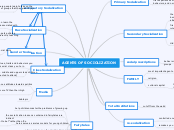AGENTS OF SOCIOLIZATION
Primary Socialization
first experiences with language, values,
beliefs, behaviors, and norms of your society
Secondary Socialization
the process through which children become
socializzed outside the home, within society at
large.
often starts with school
first introduction to bureaucracies and a system
of rules
Hidden Cirriculum
an education in norms, values, and
beliefs that are passed along through schooling
school is also a learning place for being
exposed to a variety of different kind of people
enforcement
exposure to peers
social prescriptions
behaviors that were expected of people in social groups
FAMILY
most important agent of socialization
religion
cultural capital
the non-financial aspects that are
needed for success in the real world
Total Institutions
cut off from the world
re-socialization
controlled enviroment
remakes you into the new you
Anticipatory Socialization
the social process where people learn
to take on the values and standards
of groups that they plan to join
Race Socialization
The process through which children learn
the behaviours, values and attitudes
associated with racial groups
this is where racial discrimination gets put
into a child's mind, based on what the
parent is teaching them
Gender Socialization
learning the psychological and social
traits associated with a person's sex
Class Socialization
teaches the norms, values, traits and behaviors
you develop based on the social class you're in
explains why more middle and upper class
children go to college (expected to attend)
Media
influences attitudes towards politics
lower income family watches more TV then their high income counterparts
Subtopic
Fairytales
help children master the problems of growing up
the socialization lessons contained in fairytales are indirect
heros serve as aroles models for young children
makes them ask "who do i want to be?"
rather than "do i want to be good?
allows kids to see the adult world in a
simplistic view they will understand
puts frightening themes like, love, fear, death, isolation, and abandonment in a way kids can deal with their fears
